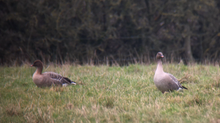Haymaking at Elm Lea Meadows

A first for us this year was making hay at Elm Lea. These are 2 interesting fields south of Cerney Wick and classed as part of the North Meadow complex. These fields are of very high biodiversity value and are Special Sites of Scientific Interest (SSSI) which means they have a high level of legal. The land is owned by Natural England (a government agency) who use local farmers to manage this and North Meadow which they also own.
The one plant Elm Lea is famous for (perhaps famous is a bit strong) is the Downy Fruited Sedge. Compared with Fritillaries this isn't a showy plant, buts it's far rarer found at only 13 sites in the UK, and this area on the wilts/glos border is its stronghold. Its also the only site in Gloucestershire for the Tufted Sedge - in short its a sedge spotters paradise! (Yes folks I ventured over the border into Gloucestershire, just).

Anyway I visited earlier in the year to have a look and found swathes of it as soon as I entered the meadow - it appears to be doing well. However head high reeds, meadowsweet and other woody plants are building up so the process of making hay is vital to keep the nutrient levels down and keep the mix of traditional hay meadow species and the sedge thriving. The deal was we had to make the hay by the end of August, as after this point another farmer had the fields for autumn grazing (another vital part of keeping the broad range of species). Back in the early summer this gave us a good couple of months to get the job done, but then the weather took a nose dive. To make hay you need 5 days of good weather. Ideally lots of sunshine, a breeze, warm and NO RAIN. From the middle of July until the 21st August this didn't occur and we had 90mm of rain. So on Friday the 25th we finally got to cut the field.

Another thing to mention is that the field contains some interesting stone features. These are relics of a water management system and you can still see where boards slotted into the stones to control the flow of water. The reserve warden from NE showed us where these were and had put up flags as the last thing we wanted to do was catch the mower on them.




So the mowing went fine, we then turned the hay twice (on days 3 and 4) and baled it on day 5. Around 130 large round bales were produced which took 8 wagon trips to get back to the farm. To access the site from Cerney Wick Lane involves driving for 1 km along a narrow track surrounded by thick hedges/woodland. Luckily I only met one group of dog walkers and to get them past I had to stop, turn off the engine, let them pick up the dog and squeeze past the tractor wheels - not the most straightforward place to get modern agricultural machinery to.
However after an excellent team effort all the bales are now back at the farm safely stored for the winter. The very best we will feed to the cattle but the hay with a lot of reeds in we will use as bedding. Another example of how cattle can be essential in preserving and improving our finest wildlife habitats.

































